MARIANI’S
Virtual Gourmet
January 31,
2016
NEWSLETTER
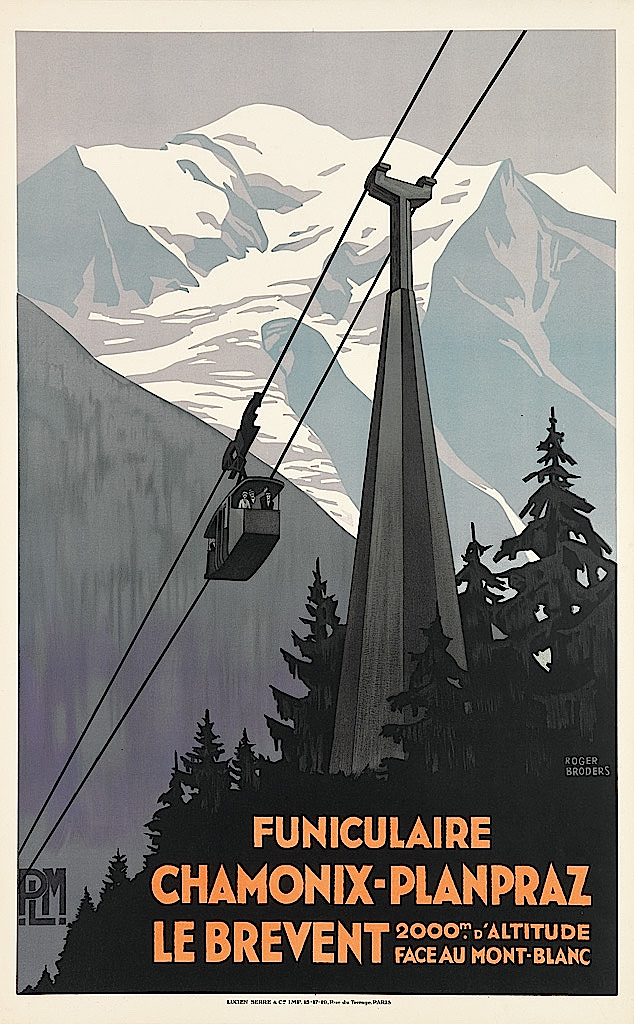
Travel Poster for the Paris Lyon Mediteranée
Company (1932) by Roger Broders
IN THIS ISSUE
RALEIGH IS FOR REAL
By John Mariani
NEW YORK CORNER
CHINA FUN
By John Mariani
NOTES FROM THE WINE CELLAR
By John Mariani
❖❖❖
RALEIGH IS FOR REAL
Part One
By John Mariani

Photo by Geoff Brown
For
a long while now when praise is bestowed on North
Carolina’s Research Triangle, Raleigh is usually
mentioned last, after Durham and Chapel Hill,
whose universities, Duke and U. of North Carolina,
grab most of the attention for their research and
high-tech clout.
But in many ways the once sleepy city 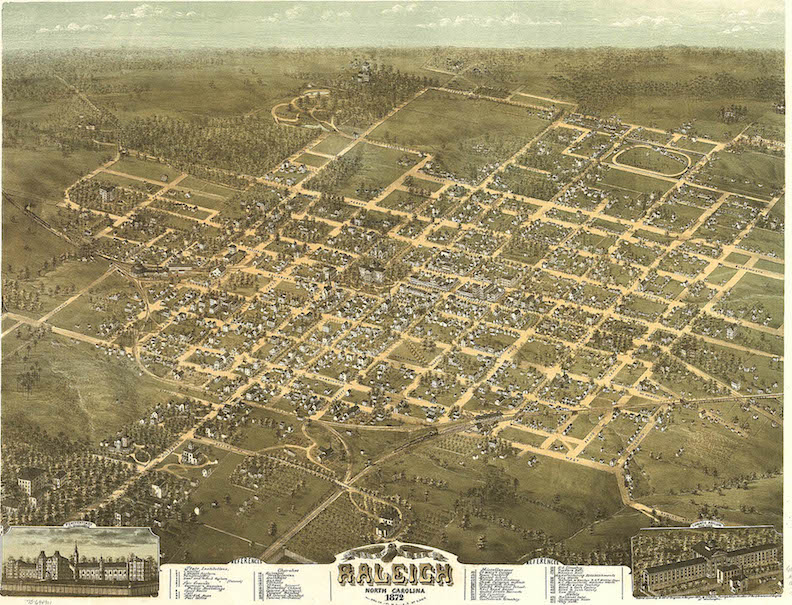 of Raleigh now has a lot
more to offer than those other municipalities,
and, during a recent trip there, I found that the
city is on a sure rise to long-delayed eminence.
of Raleigh now has a lot
more to offer than those other municipalities,
and, during a recent trip there, I found that the
city is on a sure rise to long-delayed eminence.
Raleigh most certainly has its own colleges and
universities—ten of them, including North Carolina
State and Shaw, the first black university in the
South—and its population of 440,000 is nearly double
that of Durham and seven times that of Chapel Hill. Forbes magazine
ranks Raleigh among the six fastest-growing cities
in the country.
By the end of the 18th century Raleigh was a planned
city drawn in a grid pattern (right), and the
city suffered little damage in the Civil War, so
neighborhoods retain their architectural integrity,
like Oak View County Park, which reflects the city’s
homestead history; Oakwood, with its graceful
Victorian homes; the beautifully landscaped State
Capitol area; the picnic-perfect Moore Square; and
Mordecai Historic Park, which encloses the city’s
oldest (1785) residence.
Fayetteville
Street,
now on the National Registry of Historic Places, has
the city’s first modern skyscrapers and leads from
the Capitol to the Duke
Energy Center for the Performing Arts. The
dreamers and city planners have been fully supportive of the arts
as a principal tourist draw—admirably making all the
museums in Raleigh free to everyone—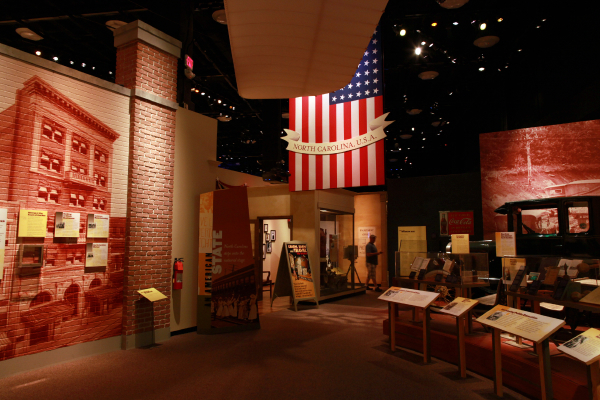 which begins
with the impressively mounted North Carolina Museum
of History (left), rich in folklore, Civil War
exhibits, displays of sports memorabilia,
African-American history, and, through July, an
exhibit devoted to Evangelist Billy Graham.
which begins
with the impressively mounted North Carolina Museum
of History (left), rich in folklore, Civil War
exhibits, displays of sports memorabilia,
African-American history, and, through July, an
exhibit devoted to Evangelist Billy Graham.
An
abandoned warehouse district can be a boon to a city
in expansion mode, and Raleigh’s is six blocks
square, anchored by the Contemporary Arts
Museum (CAM), which truly is about
contemporary artists, not modern masters. The
district is full of stores and galleries that pump
vitality into the entire region and bring light and
night venues to the streets. The
huge
30,000-square-foot Sanders Ford building (once a Ford car
dealership) has been turned into the remarkable Artspace (below) with
studios for 30 resident and guest artists and three
exhibition halls. Artspace and other municipal
projects downtown rescued the once derelict City
Market from total blight.
Unlike Atlanta, Birmingham, Montgomery and some
other Southern towns,
Raleigh is a true walking city, with several
neighborhoods falling under what’s called the Design
District, now teeming with new storefront boutiques,
antique stores, fabric shops, art galleries,
lighting 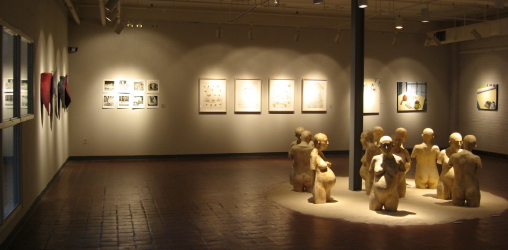 stores,
cafés and jewelers along Peace Street and Capital
Boulevard, Glenwood Avenue and Cameron Village, all
of which bring the focus back downtown from the
suburban sprawl caused by the I-440 ring around the
city in the 1980s.
stores,
cafés and jewelers along Peace Street and Capital
Boulevard, Glenwood Avenue and Cameron Village, all
of which bring the focus back downtown from the
suburban sprawl caused by the I-440 ring around the
city in the 1980s.
Just outside of downtown is Raleigh’s most
impressive cultural institution, the North Carolina Museum
of Art (below), set on 164 acres of
woodlands, with extensive collections of American,
African, Egyptian, Greek and Roman art, and an
entire room devoted to the sculptures of Rodin. When
I visited it was showing Leonardo da Vinci’s
extraordinary handwritten Codex Leicester, which Bill Gates
had bought in 1994 for $30.8 million and has since
exhibited around the world.
The city also has its own widely heralded Carolina
Ballet Company and is home to the North Carolina
Symphony and North Carolina Opera.
 As
throughout the South, college football is of titanic
importance, as manifested by the
57,583-seat Carter-Finley Stadium built for the NC
State Wolfpack. Raleigh lacks pro football,
basketball and major league baseball teams, but the
Carolina Hurricanes NHL hockey team carries on,
these days often near the bottom of the league
standings after winning the Stanley Cup a decade
ago.
As
throughout the South, college football is of titanic
importance, as manifested by the
57,583-seat Carter-Finley Stadium built for the NC
State Wolfpack. Raleigh lacks pro football,
basketball and major league baseball teams, but the
Carolina Hurricanes NHL hockey team carries on,
these days often near the bottom of the league
standings after winning the Stanley Cup a decade
ago.
If you had two or three days in Raleigh to visit,
you could get a very good read on the character of
the city by having breakfast at Big Ed’s City Market
Restaurant, on Wolfe Street since
1989 and part of the downtown revival. The Big
Ed in question is Ed Watkins, a local fellow whose
menu—the place is only open for breakfast and
lunch—is a repository of Southern and American
cookery perfected over decades and improved by the
increasing availability of great ingredients from
the Market.
I’ll say more about the food at Big Ed’s in an
upcoming article on Raleigh’s food scene, but just
to sit in the big room, whose every square inch,
especially the ceiling, is festooned with maps and
flags, toys and antiques, is to watch all of
Raleigh’s strata of society mingle, gossip, maybe
with a little more twang in their voices, and eat
way too much.
It’s all part of the city’s magnanimous
spirit, and in those lilting North Carolina voices
you’ll hear the ring of great expectations.
PART TWO WILL RUN IN
THE NEXT ISSUE OF MARIANI'S VIRTUAL
GOURMET
❖❖❖
By John Mariani
China Fun
1221 2nd Avenue (at 64th St.)
212-752-0810
chinafun-ny.com
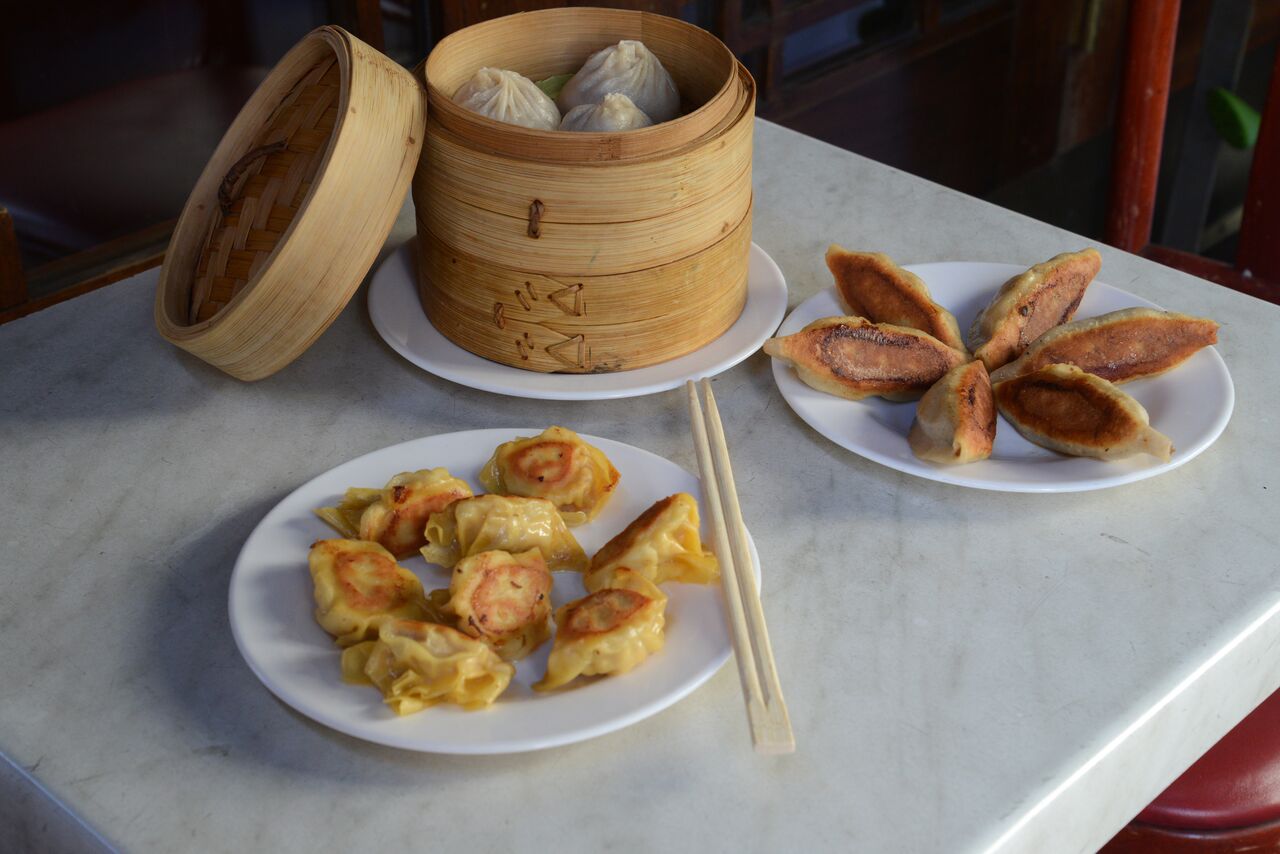 The one
thing defenders of President Richard Nixon all
give him credit for was “opening up China” in
1972, but I’ll toss in another: That opening
resulted in the export of chefs
from Hunan and Sichuan provinces to NYC
kitchens near the U.N. building, bringing with
them styles of Chinese cuisine previously
unknown in this country.
The one
thing defenders of President Richard Nixon all
give him credit for was “opening up China” in
1972, but I’ll toss in another: That opening
resulted in the export of chefs
from Hunan and Sichuan provinces to NYC
kitchens near the U.N. building, bringing with
them styles of Chinese cuisine previously
unknown in this country.
Before
long, dishes like General Tsao’s chicken, cold
sesame noodles, and honeyed ham were appearing
in restaurants with names like Hunam, Uncle
Tai’s Hunan Yuan, Uncle Peng’s and Szechwan
East, almost overnight eclipsing the old
stand-by Chinese (or Chinese-American) dishes
like chop suey, egg foo yung, chow mein, and moo
shu pork.
Before long every strip shopping center
in America had a restaurant with a name like
Hunan Balcony, Dragon Flower or Sichuan Garden.
More recently, at least in NYC’s Chinatown, there has been something of a shift to Cantonese and Shanghai-style cooking, but, overall, Chinese restaurants lost the cachet they had in the 1970s and 1980s. So, for a delectable history lesson in all these styles, I recommend a trip to China Fun on Second Avenue at 64th Street, where, since 1991, Dorothea and Felix Wu, together with Chef Wing Fone Chan, have been stir-frying, roasting and steaming hundreds of dishes that reflect Chinese food New York style. Indeed, like so many other Chinese restaurants these days, they’ve even added sushi and Japanese dishes—scores of them—to the menu.
Of course, the law of
diminishing returns sets in when a kitchen is
asked to maintain consistency with a menu so
large, ranging from dim sum and sweet & sour
chicken to nine soups, steamed “Spa Cuisine”
items, Cantonese barbecue, Peking duck and 18
“Chef’s Specials” every day and night. With
the “Lunch Special” you get a choice of 30
different dishes with soup or an egg roll, and
rice, and nothing cost more than $10.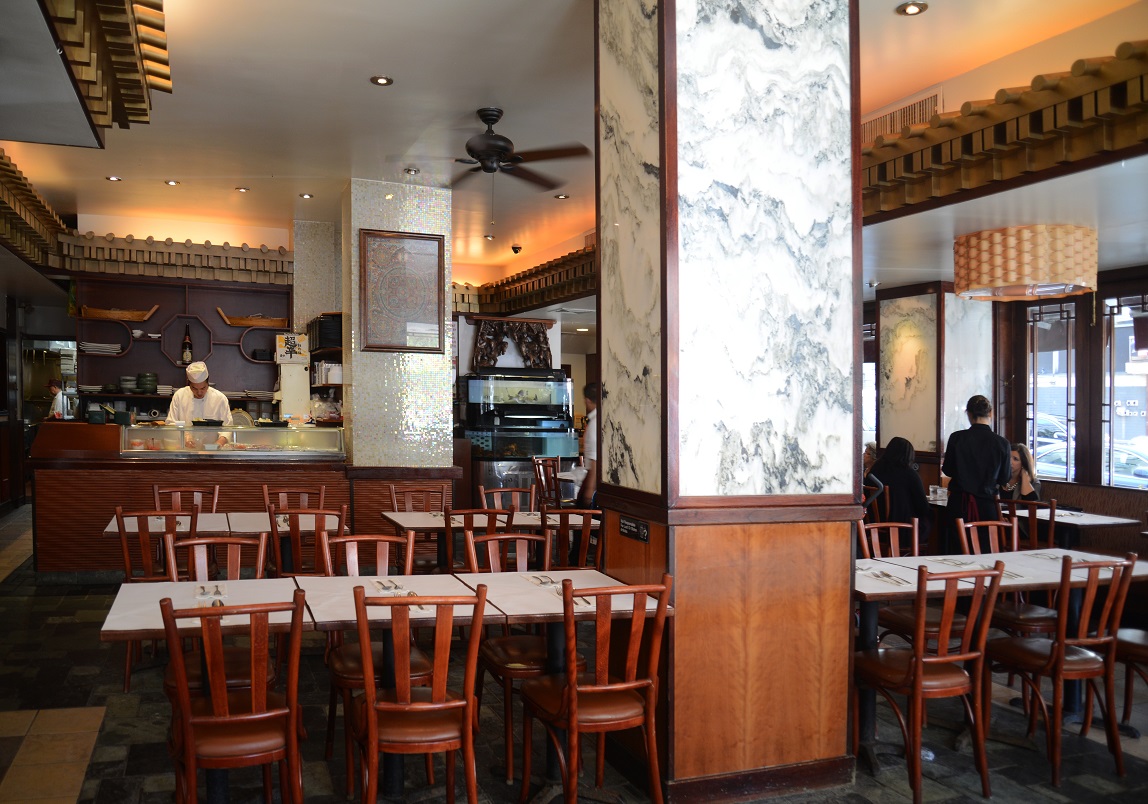
It
is easy enough to chuckle about this throwback
“whatever-you-want-we’ll make” approach, except
that my party of four found China Fun a nostalgic
trip to a time when “going for Chinese” was still
considered exciting and dishes with names like
“Shaking Beef” and “Happy Family” were as much a
part of the exotic adventure as was the prospect
of finding a paper umbrella in your way-too-sweet
mai tai (which you will at China Fun).
It was really an opportunity for my friends and me
to see just how well old-fashioned Chinese dishes
held up, and we were delighted to find how many—at
least at China Fun—really do.
The dining room is wide, pillared, and the
tables have white cloths and paper on them. A lone
sea bass swam in a gurgling tank to the rear, with
lobsters in another. Service was very cordial
and, just as I expected, delivery of the food was
fast and furious, with many dishes arrayed around
our large circular table and others on an adjacent
table.
We
ordered an array of dim sum: for the four of us
two orders ($7.75 each) of mixed
dumplings—vegetable, pork, chicken, and beef—eight
in each order, both fried and steamed. The dough
was a little thick but the flavors inside were
distinct and very good. We tried two noodle
dishes, broad chow mei fun
($11.25) in a light brown, properly sticky sauce (below), and
Singapore noodles ($12.50) lightly (a bit too
lightly) flavored with curry.
One of the best of the main dishes was a staple of
Hunan kitchens, shredded pork with garlic
($15.95), which had plenty of both (all portions
at China Fun are very generous). We just
had to order that guilty pleasure Gen. Tsao’s
chicken ($15.95)—whose origins have been much
debated over the years—and lapped it up in all its
glistening, crispy, sweet and salty glory, the
morsels meaty, the chile heat just intense enough. Lobster
with ginger (market price) was excellent, with
sweet meat inside cracked shells, assertively
spiced and clearly made for eating with your
fingers.
 The only minor
disappointment was a sea bass mounded with a
julienne of scallions, perhaps because its
delicacy paled by comparison to other dishes
already consumed.
The dish’s ample sauce was good and the
flesh nicely cooked, but it needed more spark. I did
wonder, afterwards, why that lone bass was still
bobbing in its tank after we’d ordered and
devoured our fish on a plate.
The only minor
disappointment was a sea bass mounded with a
julienne of scallions, perhaps because its
delicacy paled by comparison to other dishes
already consumed.
The dish’s ample sauce was good and the
flesh nicely cooked, but it needed more spark. I did
wonder, afterwards, why that lone bass was still
bobbing in its tank after we’d ordered and
devoured our fish on a plate.
Well, we didn’t order dessert, but you know we
were not going to refuse that most
Chinese-American of silly items—the fortune
cookie, whose sentiments seem to have kept up with
the times.
In a sense, so has China Fun, where the evolution
of Chinese cuisine in NYC is so broadly displayed
to such good effect. True, I didn’t order chow
mein or chop suey and shall leave those to
history. But
for a happy evening and consistently good food of
so many kinds, China Fun is a well-named place to
be treasured.
Open daily for lunch and dinner
❖❖❖
DRINKING NOW
By John Mariani
January is gone, February looms. It's
been a month of good winter wine.
Ponzi Vineyards Pinot Noir Reserve 2013 ($40)—I have a love-like
relationship with Ponzi’s wines: Some, like this
Reserve Pinot Noir I love a lot, others I’m
surprised are not better. (What I don’t
like is that they print their back labels with
gray 12-point type on a black background,
requiring a magnifying glass to read it.) With
13.6% alcohol, a Pinot Noir like this proves that
Oregon can make a delicious Willamette Valley
example without boosting the brawn and ripeness
through the roof.
It’s telling to read their notes on the
vintage: “The
season started with a warm spring bringing an
early bud break. From that point the growing
season remained warm and dry. . . . All went as
planned until the last week in September when the
tail end of a Japanese typhoon dropped close to 6
inches of rain on the valley and completely
saturated the vineyards. . . . We had some ideas
on how to handle it; using helicopters to dry the
vines, multiple picking passes, extensive sorting
before de-stemming and very careful winemaking,
among other methods. October saved us with three
long weeks of dry, breezy days allowing the fruit
left on the vines to reach optimum flavor without
any dilution from rain.” American ingenuity at its
vinous best!
Palmer
& Co. Brut Reserve ($50)—Complaining
about the high prices of Champagne is unlikely to
change them, but for a
very fine example at just $50, Palmer is a
producer with more than 200 growers in Montagne
des Reims where plenty of good bubbly that does
not get proper recognition. Palmer
is beginning to and at this price point it should
gain momentum. The wine has heft, a proper degree
of minerality and faint, pleasing sweetness, and
can easily be enjoyed as either an apéritif or
with any seafood dish I can think of.
but for a
very fine example at just $50, Palmer is a
producer with more than 200 growers in Montagne
des Reims where plenty of good bubbly that does
not get proper recognition. Palmer
is beginning to and at this price point it should
gain momentum. The wine has heft, a proper degree
of minerality and faint, pleasing sweetness, and
can easily be enjoyed as either an apéritif or
with any seafood dish I can think of.
Château
Larrivet Haut-Brion 2012
($25)—This sturdy Bordeaux from Pessac-Léognan is
not associated with the First Growth Haut Brion. The
property has been owned by the Gevosan family for
twenty years now, its vineyards principally
planted with Merlot (55%) along with Cabernet
Sauvignon and Cabernet Franc. Aged in
new French oak, the wine would seem to require
more time to develop, but right now its balance is
just fine for drinking at the moment, its softness
due to the amount of Merlot, so the Cabs enhance
rather than overpower the principal varietal. At
$25 it blunts the argument that good Bordeaux must
cost at least twice that to make an impression.
Augustiner
Chorherrenstift Neustift Abazzia di Novacella
Alto Adige Valle Isarco Kerner 2013 ($19)—Quite
possibly the most difficult wine name to order
from a list, this is one of the few Kerners that
come into the U.S. market, and, given its
delicious and unusual varietal character, it’s
hard to see why we don’t get more of them,
although most Kerner is made in Germany, where it
originated as a cross-breed kind of Riesling. This
one is from an 850-year-old abbey in the Italian
Alps. Its
13.8% alcohol gives it just enough weight to
provide elegance to the freshness of the fruit and
acidity. I’d as soon drink this with cold salmon
or chicken as with trout au bleu
or vitello
tonnato.
Tomero
Malbec 2014
($17)—When all the bankrolled celebrity estates go
into dithyrambs about their microclimates, soil
composition, and personal wine making
philosophies, it’s wonderful just to taste an
honest wine whose only appellation is “Uco Valley,
Argentina” and still expresses the simple
pleasures of the varietal at a price that makes it
well worth buying by the case. The
fruit is prominent but it’s tamed by slight
tannins.
Kitma
Gerovassiliou Avaton 2012
($47)—Here you have a good example of how Greek
red wines have evolved over the last quarter
century—Kitma Gerovassiliou was founded in 1981
near Thessaloniki, and today they plant a slew of
varietals including Limnio (50%), Mavrotragano
(25%), and Mavroudi (20%) that go into this small
production (10,000 bottles) wine with a smoky
undertone and formidable tannins. If
Homer’s “wine-dark sea” were as deep red as
Avaton, it would clash with Greece’s blue-green
waters. The
wine has a long life ahead of it, and with 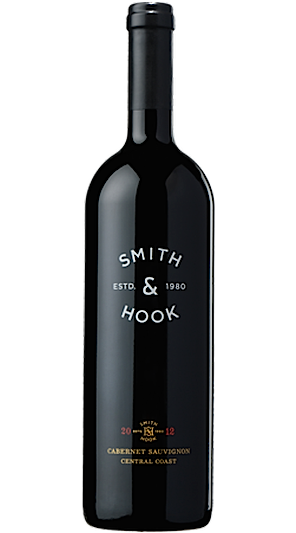 lamb it is a perfect
choice. “Avaton”
means "inaccessible"
or "impossible to reach," because the owner wanted
to make “a super premium Greek wine using only
indigenous Greek grape varietals [at a] time when
. . . super premium Greek wines were using
international varietals,” because such a level of
quality was thought to be impossible to reach. No
longer.
lamb it is a perfect
choice. “Avaton”
means "inaccessible"
or "impossible to reach," because the owner wanted
to make “a super premium Greek wine using only
indigenous Greek grape varietals [at a] time when
. . . super premium Greek wines were using
international varietals,” because such a level of
quality was thought to be impossible to reach. No
longer.
Smith
& Hook Cabernet Sauvignon Central Coast 2013 ($25 or
less)—Neither a fruit bomb nor an alcohol
blockbuster, this 100% Cab still shows some
Central Coast brawn, caused in part by the dry
warmth of the vintage season. Therefore,
you get dark fruit flavors that are tamed by the
acids from grapes gathered cooler Arroyo Secco
vineyards. There
are few 100% Cabs being made any more in
California, and S&H is one of the best, with
14.8% alcohol. Even more amazing is that I’ve seen
its $25 price tag reduced in stores to $20, which
is one reason it so often sells out.
Binomio
Montepulciano d’Abruzzo Riserva 2010
($50)—So few names help distinguish Montepulciano
d’Abruzzo wines and so much plonk is produced in
the region, so it’s always a delight when you find
one like Binomio, a ten year-old winery partnered
with La Valentina and Inama, that
expresses the best of the varietal in a riserva that
moderates its tendency towards grapey sweetness
and harsh tannins.
The pressed wine is transferred
into new and second-use French barriques, with
refining taking about 15-18 months; a selection of
the best barriques is made then the wine is racked
and goes though a light filtration, thereby
keeping much of its essence.
Boroli
Barolo 2011
($40)—There now seems more Barolo out there in the
market than ever—more than 500 producers--all with
the prestigious DOCG ranking. But while many
well-aged single estate examples have skyrocketed
in price, Boroli shows its terroir and power and
elegance with just 14% alcohol. It has
fine structure and complexity and might be kept
for another few years, but I was happy to drink it
along with a hearty winter beef stew on a snowy
evening when wines like this seem to cuddle up to
food. Achille
Boroli is just 38 years old and is passionate
about Piedmont terroir, and I think the best is
yet to come.![]()
Wente
Vineyards Eric’s Chardonnay 2014
($25)—Wente makes a great deal of wine and a great
number of bottlings--they’ve been in California
since 1883, under five generations—but this Small
Lot bottling, at 13.5% alcohol, shows just how
wonderful Livermore Valley Chardonnay can be when
not subjected to oak but only to four months in
stainless steel. You don’t get that often cloying
oakiness or wearying alcohol; instead you get the
true taste of the grape that is so much more
amenable to so many more foods.
Tenute
Cisa Asinari dei Marchesi di Gresy Barbera
d’Asti 2013
($18)—More and more with Italian food I find
myself reaching for a Barbera d’Asti, not just as
a safe and dependable choice but as a wine that
expresses everything the Barbera varietal should
be—not too bold, not too dark, with plenty of
fruit but no plumminess. Marchesi di Gresy’s family
dates back to 1797 (they also make a splendid
Barbaresco) and works from four estates; the
Barbera d’Asti’s grapes come from Alto Monferrato,
and leaving the grapes on their skins for ten days
gives the wine a richness you don’t expect at this
modest price level.
Enjoy this with winter pastas with wild
mushrooms, game dishes, and rotisserie chicken.
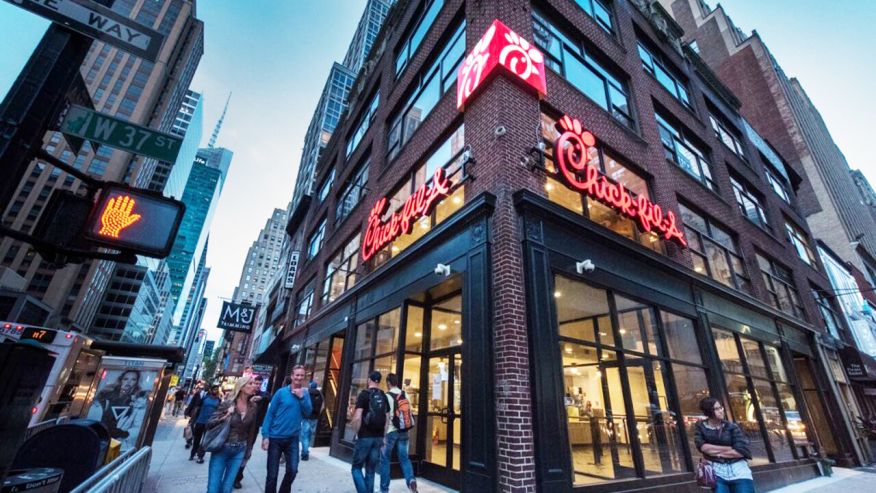 WELL, CHICK, THAT
WELL, CHICK, THAT WAS QUICK
NYC's first Chick-fil-A Grand Opening was
delayed in December when the restaurant was inspected by
the NYC Health Dept. and cited for 59 violation points,
including not refrigerating food below 42 degrees, not
properly sanitizing its “wiping cloths,” and evidence of
filth and flies was also cited. Although the restaurant
was not mandated to close by the Department of Health,
it did, posting a sign that read “To ensure we continue
to provide our guests with the best possible service and
experience, we are closing for a few days beginning on
Wednesday, December 30th for restaurant maintenance and
facility updates." It re-opened January 5th.
Next on their hit list, getting IHOP to change

to "LA MAISON INTERNATIONAL DES CRÊPES"
A Québec diner called Resto La Mama Grilled Cheese Gourmet received a letter from the Quebec language authority, which requires that all public signs, including advertising, be predominantly in French, contending that the restaurant was violating that rule by including the words “grilled cheese” in its name, and for having an ad that reads, “Enjoy Mama.” Owner Stephane Rheaume said that no customer ever walked into Resto La Mama and asked for a “sandwich de fromage fondu.” The language authority later said Rheaume would not have to change his restaurant’s name, a turnabout he insists is a result all the negative media attention the complaint drew.
Any of John Mariani's books below may be ordered from amazon.com.
 I'm proud and happy to announce that my
new book, The Hound
in Heaven (21st Century Lion Books), has just
been published through Amazon and Kindle.
I'm proud and happy to announce that my
new book, The Hound
in Heaven (21st Century Lion Books), has just
been published through Amazon and Kindle. It is a novella, and for anyone who loves dogs, Christmas, romance, inspiration, even the supernatural, I hope you'll find this to be a treasured favorite. The story concerns how, after a New England teacher, his wife and their two daughters adopt a stray puppy found in their barn in northern Maine, their lives seem full of promise. But when tragedy strikes, their wonderful dog Lazarus and the spirit of Christmas are the only things that may bring back his master back from the edge of despair.
WATCH THE VIDEO!
“What a huge surprise turn this story took! I was completely stunned! I truly enjoyed this book and its message.” – Actress Ali MacGraw
“He had me at Page One. The amount of heart, human insight, soul searching, and deft literary strength that John Mariani pours into this airtight novella is vertigo-inducing. Perhaps ‘wow’ would be the best comment.” – James Dalessandro, author of Bohemian Heart and 1906.
“John Mariani’s Hound in Heaven starts with a well-painted portrayal of an American family, along with the requisite dog. A surprise event flips the action of the novel and captures us for a voyage leading to a hopeful and heart-warming message. A page turning, one sitting read, it’s the perfect antidote for the winter and promotion of holiday celebration.” – Ann Pearlman, author of The Christmas Cookie Club and A Gift for my Sister.
“John Mariani’s concise, achingly beautiful novella pulls a literary rabbit out of a hat – a mash-up of the cosmic and the intimate, the tragic and the heart-warming – a Christmas tale for all ages, and all faiths. Read it to your children, read it to yourself… but read it. Early and often. Highly recommended.” – Jay Bonansinga, New York Times bestselling author of Pinkerton’s War, The Sinking of The Eastland, and The Walking Dead: The Road To Woodbury.
“Amazing things happen when you open your heart to an animal. The Hound in Heaven delivers a powerful story of healing that is forged in the spiritual relationship between a man and his best friend. The book brings a message of hope that can enrich our images of family, love, and loss.” – Dr. Barbara Royal, author of The Royal Treatment.
 |
The Encyclopedia of American Food and Drink by John F. Mariani (Bloomsbury USA, $35) Modesty forbids me to praise my own new book, but let me proudly say that it is an extensive revision of the 4th edition that appeared more than a decade ago, before locavores, molecular cuisine, modernist cuisine, the Food Network and so much more, now included. Word origins have been completely updated, as have per capita consumption and production stats. Most important, for the first time since publication in the 1980s, the book includes more than 100 biographies of Americans who have changed the way we cook, eat and drink -- from Fannie Farmer and Julia Child to Robert Mondavi and Thomas Keller. "This book is amazing! It has entries for everything from `abalone' to `zwieback,' plus more than 500 recipes for classic American dishes and drinks."--Devra First, The Boston Globe. "Much needed in any kitchen library."--Bon Appetit. |
"Eating Italian will never be the same after reading John Mariani's entertaining and savory gastronomical history of the cuisine of Italy and how it won over appetites worldwide. . . . This book is such a tasteful narrative that it will literally make you hungry for Italian food and arouse your appetite for gastronomical history."--Don Oldenburg, USA Today. "Italian
restaurants--some good, some glitzy--far
outnumber their French rivals. Many of
these establishments are zestfully described
in How Italian Food Conquered the World, an
entertaining and fact-filled chronicle by
food-and-wine correspondent John F.
Mariani."--Aram Bakshian Jr., Wall Street
Journal.
"Equal parts
history, sociology, gastronomy, and just
plain fun, How Italian Food Conquered the
World tells the captivating and delicious
story of the (let's face it) everybody's
favorite cuisine with clarity, verve and
more than one surprise."--Colman Andrews,
editorial director of The Daily
Meal.com. "A fantastic and fascinating
read, covering everything from the influence
of Venice's spice trade to the impact of
Italian immigrants in America and the
evolution of alta cucina. This book will
serve as a terrific resource to anyone
interested in the real story of Italian
food."--Mary Ann Esposito, host of PBS-TV's
Ciao
Italia. "John Mariani has written the
definitive history of how Italians won their
way into our hearts, minds, and
stomachs. It's a story of pleasure over
pomp and taste over technique."--Danny Meyer,
owner of NYC restaurants Union Square
Cafe, The Modern, and Maialino.
|
 |
 |
 |
 |
 |
 |
 |
 |
 Everett Potter's Travel Report:
Everett Potter's Travel Report: 
 Eating Las Vegas
JOHN CURTAS has been covering the Las Vegas
food and restaurant scene since 1995. He is
the co-author of EATING LAS VEGAS – The 50
Essential Restaurants (the fourth
edition of which will be published in early
2016), as well as the author of the Eating Las
Vegas web site: www.eatinglasvegas.
He can also be seen every Friday morning as
the “resident foodie” for Wake Up With the
Wagners on KSNV TV (NBC) Channel 3 in
Las Vegas.
Eating Las Vegas
JOHN CURTAS has been covering the Las Vegas
food and restaurant scene since 1995. He is
the co-author of EATING LAS VEGAS – The 50
Essential Restaurants (the fourth
edition of which will be published in early
2016), as well as the author of the Eating Las
Vegas web site: www.eatinglasvegas.
He can also be seen every Friday morning as
the “resident foodie” for Wake Up With the
Wagners on KSNV TV (NBC) Channel 3 in
Las Vegas.

MARIANI'S VIRTUAL GOURMET
NEWSLETTER is published weekly. Editor/Publisher: John
Mariani.
Editor: Walter Bagley. Contributing Writers: Christopher Mariani,
Robert Mariani, Misha
Mariani,
John A. Curtas, Edward Brivio, Mort Hochstein,
Andrew Chalk, Dotty Griffith and Brian Freedman. Contributing
Photographers: Galina Dargery, Bobby
Pirillo. Technical Advisor: Gerry McLoughlin.
To un-subscribe from this newsletter,click here.
© copyright John Mariani 2016

